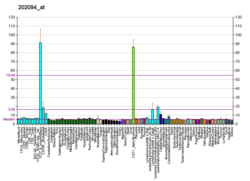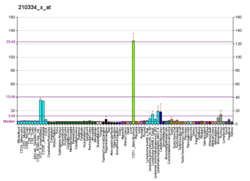Survivin, also called baculoviral inhibitor of apoptosis repeat-containing 5 or BIRC5, is a protein that, in humans, is encoded by the BIRC5 gene.[5][6]
Survivin is a member of the inhibitor of apoptosis (IAP) family. The survivin protein functions to inhibit caspase activation, thereby leading to negative regulation of apoptosis or programmed cell death. This has been shown by disruption of survivin induction pathways leading to increase in apoptosis and decrease in tumour growth. The survivin protein is expressed highly in most human tumours and fetal tissue, but is completely absent in terminally differentiated cells.[7] These data suggest survivin might provide a new target for cancer therapy that would discriminate between transformed and normal cells. Survivin expression is also highly regulated by the cell cycle and is only expressed in the G2-M phase. It is known that Survivin localizes to the mitotic spindle by interaction with tubulin during mitosis and may play a contributing role in regulating mitosis. The molecular mechanisms of survivin regulation are still not well understood, but regulation of survivin seems to be linked to the p53 protein. It also is a direct target gene of the Wnt pathway and is upregulated by beta-catenin.[8]
- ^ a b c GRCh38: Ensembl release 89: ENSG00000089685 – Ensembl, May 2017
- ^ a b c GRCm38: Ensembl release 89: ENSMUSG00000017716 – Ensembl, May 2017
- ^ "Human PubMed Reference:". National Center for Biotechnology Information, U.S. National Library of Medicine.
- ^ "Mouse PubMed Reference:". National Center for Biotechnology Information, U.S. National Library of Medicine.
- ^ Altieri DC (February 1994). "Molecular cloning of effector cell protease receptor-1, a novel cell surface receptor for the protease factor Xa". J. Biol. Chem. 269 (5): 3139–42. doi:10.1016/S0021-9258(17)41838-2. PMID 8106347.
- ^ Altieri DC (November 1994). "Splicing of effector cell protease receptor-1 mRNA is modulated by an unusual retained intron". Biochemistry. 33 (46): 13848–55. doi:10.1021/bi00250a039. PMID 7947793.
- ^ Sah NK, Khan Z, Khan GJ, Bisen PS (December 2006). "Structural, functional and therapeutic biology of survivin". Cancer Lett. 244 (2): 164–71. doi:10.1016/j.canlet.2006.03.007. PMID 16621243.
- ^ Olie RA, Simões-Wüst AP, Baumann B, Leech SH, Fabbro D, Stahel RA, Zangemeister-Wittke U (June 2000). "A novel antisense oligonucleotide targeting survivin expression induces apoptosis and sensitizes lung cancer cells to chemotherapy". Cancer Res. 60 (11): 2805–9. PMID 10850418.







